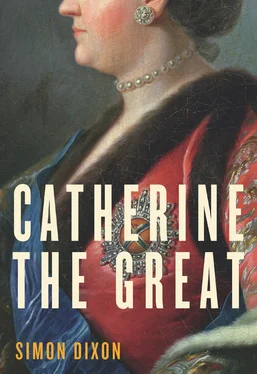* * *
She first encountered Stanislaw at Oranienbaum on 29 June 1755, when 121 guests of the first five ranks were spread across the palace staterooms at the banquet in honour of her husband’s name day. 7Though Peter had to be satisfied with toy soldiers in the winter months, he preferred drilling the real regiments he had been allowed to recruit from Holstein. An elaborate new star-shaped fort was built for their exercises. With its guns trained firmly on Yekaterinburg, Peterstadt was an excellent metaphor for their marriage. 8To avoid arguments, Catherine had bought all her own furniture for her part of the palace. But her true passion was not so much for interior design as for gardening. We cannot know how far Stanislaw discussed the subject with Catherine—on his visit to Stowe, he had risked offending his hosts by criticising ‘Capability’ Brown’s ‘natural’ landscapes—but by the time of their meeting she had both time and opportunity at Oranienbaum to create a garden of her own. ‘I began to make plans to build and plant, and since this was my first venture into building and planting, my plans became very ambitious.’ 9
When it came to ambition, the standard was set by Elizabeth herself. On arrival at St Petersburg, Stanislaw had reported home on ‘the astonishing prodigality’ of a Court which continued to look to Versailles for inspiration. In 1756, in response to requests from the francophile Ivan Shuvalov, Mikhail Vorontsov urged Russian diplomats in Paris to write ‘often and in detail’, not only about international affairs, but ‘especially about the king and his family and their way of life’. The favourite would be particularly interested, the vice chancellor continued, to receive detailed reports on the king’s lever and the toilette de la reine , and also to learn of new plays, operas and comedies, and other Parisian theatrical spectacles. 10To provide an appropriate setting for such display, his mistress had embarked on several extravagant construction projects. While the Court was in Moscow, she had initially planned a fundamental restoration of the Winter Palace, masterminded by Rastrelli from May 1753 with a budget of 567,674 roubles. By the following year, however, she had concluded that the existing building was ‘inadequate, not only for the reception of foreign ministers and the performance of ritual festivities on the appointed days in accordance with our great Imperial dignity, but also to accommodate us with the necessary servants and possessions’. So instead the Senate was ordered to find 900,000 roubles to build a new stone palace, ‘longer, wider, and taller’ than the old wooden one. 11(While the new building was under construction, the Court moved into a temporary wooden structure, erected at characteristically breakneck speed at the junction of the Great Perspective Road with the Moika canal, which probably made it easier for Catherine to conduct her affair with Stanislaw.) Meanwhile, in May 1752, the month in which Rastrelli completed his seven-year transformation of Peterhof, Elizabeth had decreed another total reconstruction of the palace at Tsarskoye Selo. The costs will probably never be known. As Catherine later remarked, the surviving accounts totalled some 1.6 million roubles, ‘but in addition to that the empress paid a lot more money out of her own pocket of which there are no records’. 12
Scarcely less fabulous sums were spent by leading courtiers, for the mid-1750s was the heyday of private building projects in St Petersburg. Catherine’s architect at Oranienbaum, Antonio Rinaldi, had initially come to Russia to build a palace for Kirill Razumovsky, brother of Aleksey. Rastrelli also accepted numerous private commissions. Delayed by the vice chancellor’s debts, it took him more than a decade to complete the Vorontsov Palace on the Fontanka, where the empress herself attended the consecration of the chapel on 23 November 1758, rewarding its exultant (and bankrupt) owner with 40,000 roubles. 13It was there, over the coming winter, that Catherine first met and befriended his fifteen-year-old niece, the future Princess Dashkova. Between 1753 and 1755, while Vorontsov was struggling to find the money to pay his builders, Elizabeth’s largesse to her favourite allowed Savva Chevakinsky to build a palace for Ivan Shuvalov on Italian Street, overlooking the Summer Palace labyrinth. 14Nearby on the Great Perspective Road, the limitless resources of his family’s salt mines allowed Baron Sergey Stroganov to complete his new palace—an innovative design, adapted to the increasing density of building in the city centre by fronting directly onto the street without a garden—in less than two years after its predecessor was destroyed by fire in 1752. 15
As Prince Mikhail Shcherbatov later complained, ‘such examples could not fail to spread to the whole nation, and luxury and voluptuousness everywhere increased’. Nobles who had once been satisfied with tallow candles were now content only with the finest white wax. ‘Houses began to be magnificently furnished,’ Shcherbatov continued, ‘and people were ashamed not to have English furniture. Meals became magnificent, and cooks who were not originally considered the most important servant in the household, began to receive large salaries…Costly and hitherto unknown wines came into use, and not only in the houses of the great.’ 16Tempting though it may be to put such grumbling down to the rhetoric of Russia’s most acerbic critic of luxury, it is worth remembering that in 1754–5 alone, the English merchants in St Petersburg imported furniture to the value of 37,000 roubles, far outstripping their continental rivals. 17And there was no limit to the pretensions of the great. Reputed to be the first private individual in Russia to plant his own pineapple orchard, Elizabeth’s principal minister Peter Shuvalov had its fruit fermented into wine and once served a dessert in the form of a mountain studded with precious stones from his own mineralogical collection. 18Mikhail Vorontsov, who frequently enjoined his nephew Alexander to live within his means, nevertheless sent him orders for expensive clarets, port and madeira from Paris and Madrid: ‘P.S. The best chocolate is made in Spain. Buy 100 lbs of it for me, and two or three pounds of the best Spanish snuff.’ 19
Catherine was aware of the competition. Looking back, she dismissed Shuvalov’s palace as ‘tasteless and ugly, though very richly appointed’:
There were a lot of paintings, but most were copies. One room had been done out in chinar wood, but since chinar does not shine, it had been covered with varnish, which made it yellow, but an unpleasant yellow that made it look nasty. To make up for this, the room was covered in very heavy and richly carved wood, painted in silver. Impressive in itself from the outside, the house was so heavily decorated that its ornamentation resembled ruffles of Alençon lace. 20
At the time, her tone was less secure. ‘I would like to know whether they were pleased,’ she wrote plaintively to Sir Charles, following a visit by his compatriots that had made her country estate resemble ‘an English colony’. The ambassador was all suave reassurance: ‘All the English who returned from Oranienbaum are enchanted. I do not believe in spells. But they are enchanted. They speak of you as if I were speaking myself. That is all there is to say.’ 21
There was more to be said about the costs. Since no account was taken of inflation, Catherine received the same annual allowance in 1761 that Elizabeth herself had been paid as tsarevna thirty years earlier. Though 30,000 roubles seems generous alongside a general’s salary of 4118—and it was a king’s ransom by comparison with the 20 roubles paid to the palace grooms—it was never enough to sustain the lifestyle to which the grand duchess aspired. (Vorontsov’s account books, kept in his own hand while the Court was in Moscow in 1753, registered an annual turnover of rather more than 35,000 roubles. But the apparently perfect balance between income and expenditure was achieved only because none of his building costs was entered.) 22Catherine’s need for money was an open secret. When Peter requested a subsidy for his German regiments in 1753, the British Resident explained to Whitehall that since the two major generals on his list were none other than the grand duke and his wife, they might not require payment, ‘though I can assure Your Grace that they want it as much as the poorest cornet or ensign in the Holstein troops’. 23Faced with the need to support their outlay, the couple became familiar figures among the foreign communities in St Petersburg, who acted, in the absence of any Russian bank, as the principal source of credit. The British led the field. So well had they cornered the market, indeed, that an envious French diplomat noted at the end of the decade that Peter treated the British merchants ‘less as creditors than as friends’. 24
Читать дальше












